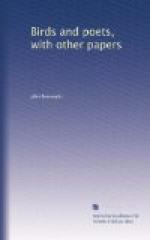When disabled so that it can neither dive nor fly,
it is said to face its foe, look him in the face with
its clear, piercing eye, and fight resolutely till
death. The gunners say there is something in its
wailing, piteous cry, when dying, almost human in
its agony. The loon is, in the strictest sense,
an aquatic fowl. It can barely walk upon the
land, and one species at least cannot take flight from
the shore. But in the water its feet are more
than feet, and its wings more than wings. It
plunges into this denser air and flies with incredible
speed. Its head and beak form a sharp point to
its tapering neck. Its wings are far in front
and its legs equally far in the rear, and its course
through the crystal depths is like the speed of an
arrow. In the northern lakes it has been taken
forty feet under water upon hooks baited for the great
lake trout. I had never seen one till last fall,
when one appeared on the river in front of my house.
I knew instantly it was the loon. Who could
not tell a loon a half mile or more away, though he
had never seen one before? The river was like
glass, and every movement of the bird as it sported
about broke the surface into ripples, that revealed
it far and wide. Presently a boat shot out from
shore, and went ripping up the surface toward the
loon. The creature at once seemed to divine
the intentions of the boatman, and sidled off
obliquely, keeping a sharp lookout as if to make sure
it was pursued. A steamer came down and passed
between them, and when the way was again clear, the
loon was still swimming on the surface. Presently
it disappeared under the water, and the boatman pulled
sharp and hard. In a few moments the bird reappeared
some rods farther on, as if to make an observation.
Seeing it was being pursued, and no mistake, it dived
quickly, and, when it came up again, had gone many
times as far as the boat had in the same space of
time. Then it dived again, and distanced its pursuer
so easily that he gave over the chase and rested upon
his oars. But the bird made a final plunge,
and, when it emerged upon the surface again, it was
over a mile away. Its course must have been,
and doubtless was, an actual flight under water, and
half as fast as the crow flies in the air.
The loon would have delighted the old poets. Its wild, demoniac laughter awakens the echoes on the solitary lakes, and its ferity and hardiness are kindred to those robust spirits.
XII
One notable difference between man and the four-footed animals which has often occurred to me is in the eye, and the greater perfection, or rather supremacy, of the sense of sight in the human species. All the animals—the dog, the fox, the wolf, the deer, the cow, the horse—depend mainly upon the senses of hearing and smell. Almost their entire powers of discrimination are confined to these two senses. The dog picks his master out of the crowd by smell, and the cow her calf out




